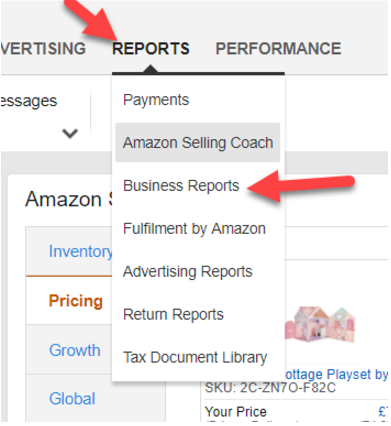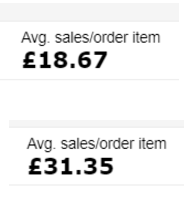Make More Money on Amazon by Selling Less Products

Guest blog post by Dan Ashton
I have been selling on Amazon for around two years, selling in the US, UK and across Europe. Six months ago my wife joined my Amazon team alongside two full time Virtual Assistants who help with the online arbitrage part of the business.
Pop Quiz. Which of these do you agree with?
1. To make more money selling on Amazon I need to sell more products
2. To make more money selling on Amazon I need to sell less products
Ok, I won’t keep you in suspense. No. 1 is the obvious answer, but what if I told you that No. 2 is also true? You don’t believe me? Good – read on and I’ll prove it to you.
In fact, I’ll even show you how you can make more money on Amazon by not increasing your inventory.
Average Selling Price
I don’t know you well enough yet to hold your hand, so instead I’m going to walk with you through Amazon Seller Central and show you some stats that if you don’t already know, you really should.
First, in Seller Central, go to reports > Business Reports

You are now on your Sales Dashboard. To find out your Average Selling Price, select the date range you want to look at, and click Apply:

Average Selling Price = the average sales price of each order. So $ divided by units sold.
I would recommend looking at the last week, the last month and the last year to give yourself an idea of what your ASP has been like. Generally the last week will be too short period to get too much useful data from.
I find a month, or custom date range of three months, gives a good enough snapshot.
Why is this important?
Here are some examples based on different time periods in my Amazon seller account

That’s fascinating Dan, but so what?
Well it means that in the first time period on average, each item I sold was for a value of £18.67
In the second picture, on average each item I sold was sold for a value of £31.35
Let’s assume that I maintained a minimum Return On Investment of 30% (I aim for higher, but this is an example).
That would mean that in the first time period above, my average profit was £5.60
In the second time period above, my average profit was £9.41
(there are variables to take into account, such as Amazon fees etc. but I want to give you the general idea).
So to make £100 profit in time period 1 I would need to sell 18 products, in time period 2 I would need to sell just over 10 products.
If you’re still not sure, another way to look at it is that if I sold 10 items in the first scenario, I would have made £56 profit. I’d only need to sell 6 products in scenario 2 to beat that and make £57 profit.
Pros and Cons Of Increasing ASP
Pros:
-
Easier to scale your business if you are not having to buy lots more lower priced items to increase your revenue
-
Less per item Amazon fees if you are selling fewer products to make the same or more money
-
You will have a higher quality inventory, and will be have more flexibility with your repricing.
-
If you need to reduce your prices to sell, your ROI may drop but you should still be able to make a decent net profit
Cons:
-
It’s not always that easy to find higher priced items to sell
-
When you get a refund, it hits you harder with a more expensive item
-
Some higher priced items make take longer to sell
How To Do It
When you are sourcing, increase your minimum selling price. If you are using sourcing software, there are usually filters that will allow you to do this.
Maintain your minimum Return On Investment. This is vital – making £50 profit on something that is only 10% ROI is not better than making £10 profit on something making 100% ROI. How you make your money work for you is important. So whatever your minimum ROI is now (e.g. 30%) – keep it at that.
Try sourcing in different categories than you do now. Try moving away from Toys for example to higher priced electronics, or clothes and shoes.
If Proof Is In The Pudding, Let’s Have Some BQool Pie
Let’s take a look at two items in Bqool. Both have similar long term selling history (the more expensive item will probably take a little bit longer to sell, but having an inventory that has products selling over time rather than quickly with less profit isn’t necessarily a bad thing:
Product one:

Product two:

You may be more nervous investing in inventory that costs £124 per unit as opposed to £17 per unit. I get that, and I wouldn’t recommend suddenly changing your sourcing strategy to only buy higher priced items.
What I would suggest is that you start gradually increasing that part of your inventory, so that you can see your ASP increasing each month, your revenue increasing each month, whilst maintaining a good mix of different type of products.
As well as using BQool for repricing, you can see from the images above that it’s also really useful for reviewing the typical ROI and returns across your inventory.
So have I proven that you can make more money by selling less products?
Yes Dan, you have.
Good, that makes me very happy.
This is your business, you want to grow it – by following the above strategy you can take actionable steps to do just that. I’m off to check my inventory now – I practice what I preach you know!
 Biography: Dan Ashton is an experienced Amazon seller and entrepreneur. Due to the success of his online businesses over the past two years, Dan has moved from Liverpool, UK to the beautiful Mediterranean island of Mallorca, where he continues to work to build and expand them further. Dan shares his experiences and helps others to establish their financial freedom via his website www.danashton.co
Biography: Dan Ashton is an experienced Amazon seller and entrepreneur. Due to the success of his online businesses over the past two years, Dan has moved from Liverpool, UK to the beautiful Mediterranean island of Mallorca, where he continues to work to build and expand them further. Dan shares his experiences and helps others to establish their financial freedom via his website www.danashton.co









July 11, 2017
Hi Dan, I have FBA Wizard Pro but struggle to use it what strategies do you recommend? Thanks, John
July 12, 2017
Hello John,
Thank you for leaving your comment. I’ve forwarded your question to the author, Dan and he will contact you privately.
If you have other questions, please feel free to contact us or Dan.